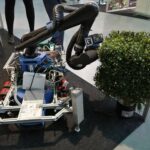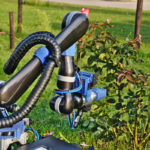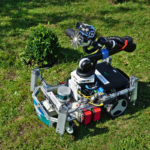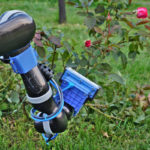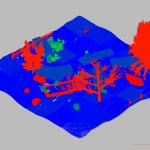With the above introduction, we list the project’s measurable objectives, covering both scientific research and innovation. Essentially all of these objectives are innovative, but at the same time will lead to a prototype with considerable commercial potential.
- Autonomous garden robotic bush trimming: This is the overall objective. We will research, build and demonstrate a robot navigating in a garden context to plants of interest and trimming them back to the specified shape.
- Development of a low-cost physical robot able to trim bushes: Bosch’s Indego lawn mower platform will be modified to carry an arm stably.
- Development of a computer controlled trimmer suitable for mounting as a robot end-effector: These do not exist, and will require power management, force sensing and jam detection.
- Development of algorithms to fuse multiple shape-from-X capabilities to create a reliable 3D scene shape description: This is achieved by fusing binocular stereo, motion stereo, structure and motion and using feedback from the fusion to improve the individual 3D extraction and description processes – a key vision innovation.
- Development of algorithms to acquire an accurate outdoor 3D scene map and description: This is a challenge because of changing lighting conditions, and because most objects will not have solid surfaces, e.g. bushes, plants and trees, unlike the objects typically found indoors and in laboratories.
- Development of algorithms for navigation in a restricted and cluttered outdoor environment with changeable illumination conditions: The robot will have to cope with a variety of lighting conditions due to weather and time of day, as well as closely placed scene structures (e.g. bushes, statues, ponds, walls).
- Development of algorithms for relating visual SLAM-based 3D scene maps to user-supplied sketch maps of the garden and ideal topiary shape: This requires both shape and semantic understanding to link the two maps, as the sketch will not be metrically accurate, whereas the SLAM map will not have attached semantic information. This objective also includes algorithms to use the 3D metrical plus sketch information for robot navigation, servoing and trimming control.
- Development of algorithms for overgrown bush analysis: This requires computing a 3D local shape based on the individual overgrown leaf and branch structure, as well as the underlying ideal surface shape.
- Development of algorithms for 3D visual servoed bush trimming: The bush will change shape and also move in response to the forces supplied by the trimmer.
- Evaluation of the complete integrated robot: This includes localisation and trimming accuracy, navigation and aligning the robot and clipper to targets, trimming the plant to a desired shape.
- Training of junior research staff in robotics and 3D vision skills: we estimate approximately 50 person-years of combined robotics and 3D computer vision training for the combined pre- and post-doctoral researchers working on the project.
Although it is clear that the prototypes developed in the TrimBot2020 project could lead to a commercial product (e.g. TRL 9/10), that is not the goal of this project (which is for getting from TRL 1/2 to 5/6). Accordingly, there are aspects that are desirable in a future commercial product that are not objectives in this project. These include: a convenient user interface for garden and task specification, integration of both mowing and trimming capabilities on the same platform, initial trimming of a `raw’ plant into a desired shape, safe operation near to humans and pets, and engineering for cost-effective manufacture.

